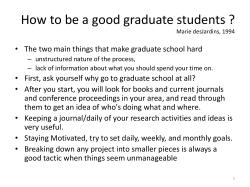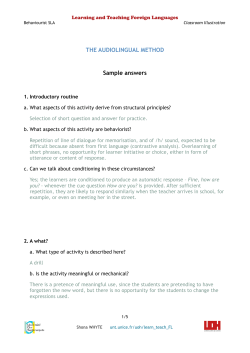
Document 258767
Distributed Learning Course Proposal Cover Sheet Please complete this cover sheet and include it with your Distributed Learning Course Proposal and a copy of your Intellectual Property Agreement. It is not necessarv to submit an Intellectual Property Agreement for videoconference courses that are not being recorded for future distribution. Course proposals shall be submitted to the Office of the Vice President of Academic Affairs for final consideration. Department: Chemistry Course Number: CHEM 5380 Course Title: Organic Chemistry Mode of Instruction: WebCT Location(s) (if site-based): Effective Term: Spring 2004 Submission Date: January 14,2003 Is the proposed distributed learning course in the existing UNT course inventory? a e s mo NOTE:If the course is not in the existing UNT course inventory, it must receive approval as a new course before this distributed learning course proposal is submitted. After approval, if mode of delivery changes, a new course approval will be required (e.g. videoconference changes to Web-based course) If this proposal is reviewed by the Center for Distributed Learning, please have a representative provide a signature: CDL representative: Date: Please attach a copy of the Intellectual Property Agreement (required) for this course. The copy must contain signatures of faculty member, department chair and dean. Other approvals may still be pending. REQUIRED SIGNATURES Dean: Provost/V.P. of Academic Affairs: Date: ;fdYf& Distributed ü earn in^' CourseProgram Proposal Form - Please use this form in the preparation of a course or program proposal to be submitted for approval. Please attach the appropriate course or program cover sheet and secure the necessary signatures. Need and Marketing 1 . Describe how this course or program fits within the Mission of UNT The target audience for this course is students enrolled in the chemistry graduate program at UNT. The online version of this course will be valuable as a course for graduate students who can excel at the own rate and will add to the number of courses that UNT has available to fulfill the requirements of the Industrial master's degree. 2. Describe how the needlmarket for the course or program has been established. Several online graduate-level chemistry courses already are in place for analytical, computational, and physical chemistry. The addition of this proficiency course will complement the existing courses and increase the marketability of the UNT Industrial Chemistry degree. In addition there are plans to have this course marketed outside of the United States, namely to India. - 3. Describe the plans for marketing the course or program. Most of the pre-publicity has been accomplished by having most of the Industrial Chemistry degree available via WebCT. This additional course will be marketed through the same route as the previous courses: state and national conferences, department's Web page, and graduate recruiting programs. Curriculum and Instruction 1. Describe the programlcourse including content and type of learning (factual, conceptual, application, psychomotor, attitudinal) and type of student (motivation, individuallgroup learner, special needs, and other relevant characteristics). This course is a survey of organic chemistry involving a systematic study of classes of reactions with an integration of fact and theory. The type of learning will be factual, conceptual and have many applications to the classroom and society, in general. The majority of the students enrolled in this course will be mainly from industry, but also may include approved students who are unable to attended an on-campus course or who desire an alternative course environment. Distributed - ü earn in^' CourseRrogram Proposal Form 2. List any special challenges that the distributed learning environment poses for the students. I None are anticipated. I 3 . Describe how the necessary interaction between faculty and students will be provided. This course may have both an online and traditional classroom offering. Interactions in the online course will be in the form of email, WebCT discussion sessions and specific chat rooms on special topics as they arise. 4. Describe how the course/program differs from the corresponding course/program offered in a non-distributed mode. Both course settings promote the conveyance of factual knowledge. The advantage of the online version of the course is great for students employed in industry and having both offerings will allow for employed students to fit academic preparation into a limited timeframe. Delivery of the online version allows asynchronous learning, so that more students will have greater flexibility with time management. 5. Describe how comparable student learning is assured. Assessments of both versions of this course will depend on traditional examination questions along with a variety of original projects that can be either Web-based or more traditional--in fact integration of these learning environments will be encouraged in both versions. Distributed ü earn in^' CourseProgram Proposal Form I I I Resources 1. Explain how faculty will have the time to develop the course(s). This course will be developed by a team of graduate Research Assistants under the direction of a Subject Matter Expert (Dr. Michael G. Richmond). 2. Describe which sources of funding- have been identified (course fees, contracts, internal and external grants, and distributed learning funding model). Dr. Mason has been awarded a UNTITIF grant to support part of the development of this course. Also one of her Chemistry Education graduate students is pursuing the development of this course as part of his doctoral dissertation. 3. Describe what resources, if any, will be needed from the Center for Distributed Learning. Questions regarding programming as they arise and instructional design advice and I assistance I Student Services 1 . Describe how will students be admitted. registered. and advised Students will need to be accepted to graduate school prior to registering for CHEM 5380. Dr. Richmond is also the Graduate Advisor for the Department of Chemistry. He will be assisted by Susan Brockington, Student Advisor for the Department of Chemistry, who will work directly with all graduate students. 2. Describe how will students be trained in the instructional technology used. The introductory assignment for students will be the online introduction offered by WebCT on how to use the system. Faculty Support 1. Describe how faculty will be prepared to teach in the distributed learning environment. Dr. Richmond will complete the four courses leading to the Excellence in Teaching Online Certificate offered by the Center for Distributed Learning (CDL). 2. Describe how facultv will obtain access to the necessanr instructional technolom. I Dr. Richmond has access to the necessary technology both in his office and home. 3. Describe what com~ensationthe facultv will receive for teaching. Dr. Richmond will be given a task payment from the UNT/TIF grant awarded to Dr. I Mason. 4. Describe the arrangements that have been made regarding ownership of materials generated in the course(s). Intellectual Property Agreements are being filed. I I u Distributed ü earn in^' CourseProgram Proposal Form Resources for Learning 1. Describe how access to library materials and readinghiewing materials will be obtained. Instructional materials including the text will be mailed to students who enroll in this course, if they are unable to find the text elsewhere. Other materials are currently available online. 2. Describe any special laboratories, equipment, or facilities that will be required for the course/program and how these will be provided. No special laboratories, equipment, or facilities are required for this course. Virtual laboratory experiences will be incorporated into the online course. Commitment for Support 1. Designate who is the instructional leader(s) for the revision or creation of the distributed learning coursework. I Dr. Michael G. Richmond 2. Describe how a student will be able to finish a full program of studies. This course complements the other existing online courses necessary for the Industrial master's degree offered by the Department of Chemistry. It is the goal of this Department to have enough course selections that this entire program can be completed online. 3. Verify that the method of delivery being used is a supported item at UNT (Academic Computing, Center for Distributed Learning, etc.) or designate how this technology will be supported. The UNTITIF grant will support the development of the courses. Course fees will provide continued support. 4. Provide the nameslaffiliations of those who you have consulted with in preparing your distributed learning proposal (Center for Distributed Learning, departmental contacts, external consultants, etc.), if any. I T. Jones of Thinkwell, Inc. Distributed ü earn in^' Course/Program Proposal Form I Evaluation and Assessment w 1. Describe how student learning, student retention, and rtudent/faculty satisfacticr! are assessed. Content exams and completion of course projects will assess student learning, student evaluations and evaluations from the external grant evaluator, Lee Hughes, Department of Biology. 2. Describe how support services, technology effectiveness, faculty and student training, and other program aspects are assessed. 1 Lee Hunhes will describe the effect of these a s ~ e c t of s the Promam in his evaluation. 3. Describe how program or course announcements are made. I WebCT announcements on the MyWebCT page of Dr. Richmond. 4. Describe how distributed learning students keep in contact with the main campus and with each other. Preferred method of communication is WebCT, especially for student-student interaction; Departmental phones and FAX are also available. 'A course is considered delivered by distributed learning if the faculty and student are not physically present for at least 50% of the time and if the medium of transmission is digital (Web, Internet, Videoconference, CD-ROM, etc.). A program is considered delivered by distributed learning if over 50% of the courses are delivered via distributed learning.
© Copyright 2025





















